The Big Business of Local Food
Local food is gaining traction in the traditional food supply chain. Only recently relegated to farmer’s markets and the occasional community supported agriculture program (CSA), local foods are making big waves in grocery stores, restaurants, and more recently, schools and institutions. Driven by increasing consumer demand, the USDA estimates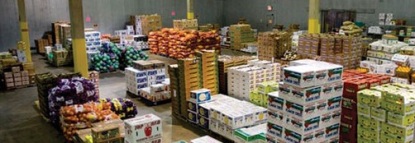 that in 2014, local foods represented an 11.7 billion dollar market. That market is expected to grow to over 20 billion by 2018.
that in 2014, local foods represented an 11.7 billion dollar market. That market is expected to grow to over 20 billion by 2018.
Consumers, perhaps initially drawn to local food as a trendy buzzword popularized by media food gurus like Michael Pollan and movies like Food Inc., are becoming more sophisticated in their understand and definition of local food. A recent consumer survey conducted by management consultants, A.T. Kearney, found that in 2015, the percent of people providing a definition of local food is higher than measured in the two previous years. In addition, definitions were more complex and included concepts of distance, growing practices or processing methods. It’s clear consumers are demanding locally produced foods and that their knowledge and experience with locally produced foods is growing with their demand.
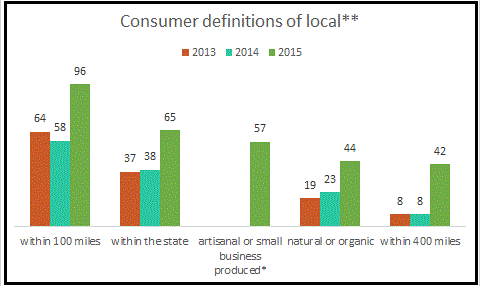
*New category in 2015 ** Consumers could pick more than one answer Source: AT Kearney
Traditionally, local food distribution has occurred primarily via direct to consumer markets like farmer’s markets and community supported agriculture (CSA) programs. At the same time local food demand is growing, growth in direct to consumer markets is flattening out. The USDA reports that between 2007 and 2012, the number of farmers engaging in direct to consumer sales increased by 5.5%, while the actual sales decreased by 1%. Not every consumer interested in local food may have access to or wish to purchase produce via a direct to consumer outlet. To get local food into large chain stores where these customers can find the products they are demanding, a new business model is required. Food hubs are that business model. In contrast to direct to consumer market sales, The USDA reports that local food sales are increasing in intermediated markets, of which food hubs are type.
Small Farms, Big Ideas
In addition to accessing new markets for local food, food hubs primarily work with small and mid-sized farms. Large scale agriculture systems do not operate on the scale that can effectively produce and distribute locally produced food locally. Small and mid-sized farms can fill this gap and what’s more, this market has the potential for more lucrative margins than large scale agriculture and can help stabilize the shrinking number of small farms. But, there are some big problems that come when small farms try to service big volume customers like grocery stores. In addition to large quantities, large volume customers also require truck capacity, refrigeration, packaging and in some cases, processing. It’s logistical infrastructure which most small farms can’t afford to provide.
While meeting demand on the consumer end, food hubs are filling the logistics gap that keeps small farmers from getting their foot in the door with large volume customers. In general terms, Food hubs are businesses that actively manage the aggregation and distribution of source identified, local food. The video, “Local Food in Every Cart”, produced by Red Tomato, a large food hub operating in New England is an easy tutorial on how and why food hubs work.
A Kinder, Gentler Distribution System
Food hubs may take many legal structures and may serve direct to consumer, retail, institution or any combination of these three markets. However, the legal structure and market mix are less important to defining food hubs than what the food hub does. There is general agreement that food hubs are characterized by similar coordination, partnership, marketing and community activities.
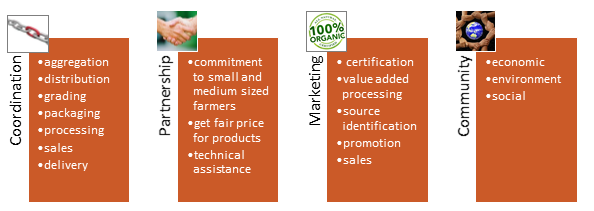
In November 2015, I had the honor of presenting findings from the collaborative research efforts of the Center for Regional Food Systems and The Wallace Center at Winrock International to shed light on the scope and function of food hubs nationwide. The 2015 National Food Hub Survey along with its predecessor, the 2013 National Food Hub Survey, represent the first longitudinal data available about food hubs. The 2015 survey, answered by 151 food hubs, contained items about coordination, partnership, marketing and community. Let’s dig a little deeper using this framework and see what makes a food hub a unique food distribution model and how food hubs can be seen, not just as filling a logistical need, but as important agents for food system change.
Just a note before we get going. I’ll talk a lot about the 2013 and 2015 National Food Hub Survey results. To make things easier on you and on my poor typing skills, I’ll just refer to them as 2103 and 2015.

My mentor, Rich Pirog told me once that food hubs were like snowflakes- no two are ever alike. Hundreds of statistically non-significant correlations later this research says, “Yup, Rich was right!”. Well, he was mostly right. To be a food hub you, at least, need to put significant effort into bringing food from different producers together (aggregating) and selling that food to different buyers (distributing). Some hubs have a fleet of box trucks while other take a more hands off approach and act as brokers. Some food hubs do all their business online and some have sales reps with territories and farmers and stores to keep happy. Some are multi-producer CSAs and some serve large grocery stores in a muti-state region. Regardless, at a minimum, you have to aggregate and distribute from multiple producers to be a food hub.
There’s one other thing and this one causes much disagreement over semantics; you have to do it “locally”. The USDA defines local or regional as within 400 miles and in the next breath, says there’s no definition. In 2015 hubs defined local as areas small as within their county or as large as several states; as small as a hundred miles or as many as 400 miles. Others said within a day’s drive or left it up to the customer to decide what was local enough. Whatever definition is chosen, the agreement between all parties is that the food meets their definition of local.
Food hubs don’t just move fresh produce through the value chain, they also work with locally produced or manufactured value-added products such as cheese, baked goods, sauces, jellies and in some cases, non-food products like soap. About one out of five food hubs work with only one category of product like fresh fruit or meat, but most work with multiple product lines and almost of the time that includes fresh produce. Almost half of food hubs carry 6 or more product categories. From hand-crafted laundry soaps to organic stone ground flour, that’s a grocery store’s worth of variety!
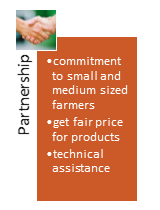
On the supply side, food hubs have partnerships with both farmers and small businesses that manufacture value added products. In 2013 and 2015, hubs reported they moved product from an average of 80 businesses. About a third of 2015 hubs were less than three years old. That means the number of food hubs is growing fast, but what’s important here is that food hubs that are just getting off the ground tend to have fewer suppliers they work with, so that may explain why the average number of suppliers didn’t change much since 2013. Hubs that answered in both 2013 and 2015 increased the number of suppliers they work with by 31% in that same two year period.
Nine out of ten hubs get product from farms and ranches. One in four hubs has their own farm, sometimes called an incubator or teaching farm, from which they get product and train new and existing farmers how to grow more effectively. That’s important not just because it means more supply for the food hub, but because it helps create a strong, ecologically educated and diverse farming population- that’s a great pro-social goal. I’ll get to that later!
But, are food hubs benefiting small scale farmers? Nine out of ten hubs gets all or almost all of their fresh product from farms that make less than $500,000 in sales per year and work day-to-day helping small farmers get access to markets. Hubs also provide a variety of technical assistance, that their larger, traditional counterparts don’t. From crop scheduling to helping farmers develop plans to keep crops safe for human consumption, food hubs are bringing it!

Perhaps it is a part of the sense of partnership they have with their suppliers or perhaps it just makes good business sense; food hubs provide a large variety of services to their suppliers. From on-farm pick up of products (70%) to packaging to meet buyer specifications (59%) to minimal (freeze 22%, cut 17%) or more intensive (can 10%, licensed shared use commercial kitchen 15%) processing, food hubs are investing in their suppliers to build both the suppliers’ and the food hub’s business. Eight out of ten food hubs provide marketing and promotional services. Two-thirds help with preserving product origin though stickering, etc.
Food safety, a looming issue with the impending changes associated with the Food Safety and Modernization Act (FSMA), is something almost all food hubs are concerned about and almost all worry that suppliers will have a hard time meeting requirements under FSMA. Most hubs will assist with food safety plans and 43% will help with or offer the most common food safety certification for small farms, Good Agricultural Practices (GAP) training. Food hubs are at the farms, visiting the farmers and providing services and infrastructure to help them succeed.

Most food hubs can be categorized as social enterprises and many are owned by social entrepreneurs. A social enterprise is a business, of any legal structure, that has both as its core mission and value proposition a pro-social goal or goals. Earlier, I said that you aren’t a food hub if you don’t operate “locally.” That particular fact is also the common pro-social goal among all food hubs. Fischer (2015), in analysis of the 2013 survey said it well: “Food hubs are, or intend to be, financially viable businesses that demonstrate a significant commitment to place through aggregation and marketing of regional food.” Every food hub representative surveyed in 2013 and 2015 mentioned something akin to this definition in their written mission statements.
Beyond aggregation and distribution, food hubs are engaged in many other activities that demonstrate commitment to place. Two out of three food hubs worked to increase good environmental or animal welfare production practices, improve community health and/or make sure they paid their employees a fair wage. Hubs engaged in positive externalities. That’s the economist’s way of saying in terms of pure profit, there’s not a compelling business reason to be spending time and resources on such activities. For example, it’s cheaper to throw out unsold produce rather than sort it, repack it, and use your trucks and staff to drive it over to a food bank. But, 83% of food hubs do just that. Seventy nine percent work to provide education about community food systems issues. Half offer nutrition or cooking education and 6% offer health screenings.
In every domain, I’ve given examples of how food hubs are very different from traditional supply or value chains. In fact, many use “values chain” to describe both how food hubs add financial and social value to the troubled food system.
Multiple Models
While food hubs share many similarities they can be very different operationally and structurally. In these videos, two hubs, both in Michigan and both very different from each other, are highlighted. Allen Marketplace Exchange Food Hub is a new extension of the Allen Neighborhood Center. The Allen Neighborhood Center already had an existing farmers market and CSA when they decided to add an online exchange for restaurants and institutions to purchase large quantities and a licensed commercial incubator kitchen.
In contrast to the overarching non-profit structure in which the Exchange exists, for-profit Cherry Capitol Foods in Traverse City, at first glance, resembles a very traditional small food distribution business. But, in true food hub fashion Cherry Capitol shows a strong hands-on commitment to famers and the local community.
Imagining Impact
So, here’s where I’m going to get a little cautiously creative with the numbers. That’s something an academic expected to publish doesn’t get to do all that much. Because food hubs are a new business model and because they are self identified, no one is really sure how many food hubs there are in the United States and that causes some statistical problems making inferences about all food hubs based on the results of any survey. Experts are pretty sure there is at least 350 in the United States. So, for illustrative purposes only, I’ll to use this number to try to get some perspective on the total impact of food hubs.
If there are 350 food hubs in the United States then food hubs might expect to…
- Generate over 1 billion in revenue
- Employ over 4,200 full and part-time individuals
- Help about 28,000 farms and other suppliers find markets for their product
- Contribute to the social and environmental well-being of 350 communities
Last, but not least, is an obviously critical piece for food hubs to be long term business and social solution. They have to stay in business. That means they have to make enough to pay the bills. Even if including new hubs and heavily grant funded hubs, 3 out of 4 hubs are breaking even or better. From 2013 to 2015, hubs, on average, went from losing money to making a profit. Same hub comparison between the years show the most dramatic and certain results. These hubs went from an average 4% profit in 2013 to an average 16% profit in 2015.
Final Thoughts
Questions still remain. What makes a food hub profitable? Can social goals fit, long term, with financial goals; particularly when any grant funding runs out? Food hubs agreed that with increasing demand for local 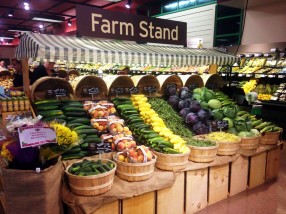 food will come increasing competition. Can food hubs keep a competitive advantage as farmers try their hand at selling direct and other bigger players try to get in on the local action?
food will come increasing competition. Can food hubs keep a competitive advantage as farmers try their hand at selling direct and other bigger players try to get in on the local action?
Certainly, food hubs are not a panacea for all the ills of the food system. Nor are they the only trajectory for scaling up local and regional food. But, for now, food hubs, are receiving a lot of attention from government, non-profits and savvy social entrepreneurs. The attention is warranted. These flexible evolving social enterprises are making “growing” impacts on the status quo of the conventional food system.
Sources
All sources not listed here are available through hyperlink within the article and on the resources page.
Fisher, Micaela, Rich Pirog and Michael W. Hamm (2015) Food Hubs: Definitions, Expectations, and Realities, Journal of Hunger & Environmental Nutrition, 10:1, 92-99.